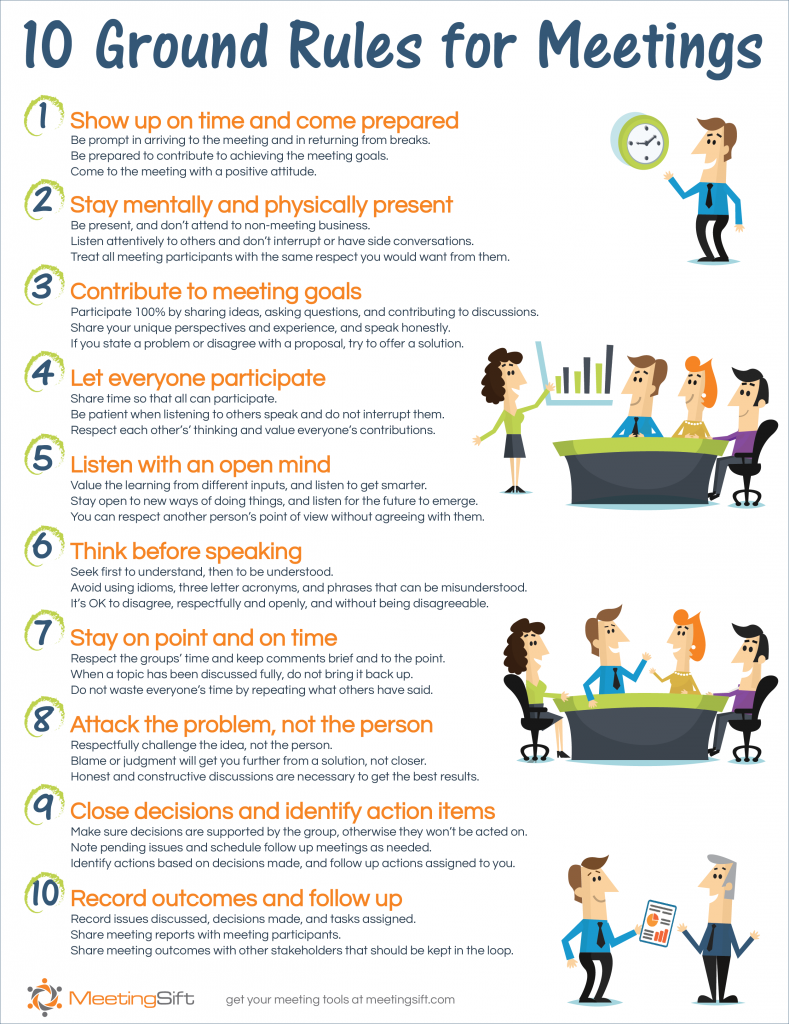Why are some meetings highly productive while others end up being frustrating chaos?
In addition to having a meeting agenda that guides meeting participants towards accomplishing the meeting goals, participants of productive meetings have a clear understanding of what is expected of them to best support this process. This is where meeting ground rules come in to play.
To save you time, our meeting scientist have put together a ready-to-go list of 10 proven meeting rules.
Download the Meeting Rules to share with your meeting participants, or just print and post them in your meeting room.
1. Show up on time and come prepared
Be prompt in arriving to the meeting and in returning from breaks.
Be prepared to contribute to achieving the meeting goals.
Come to the meeting with a positive attitude.
2. Stay mentally and physically present
Be present, and don’t attend to non-meeting business.
Listen attentively to others and don’t interrupt or have side conversations.
Treat all meeting participants with the same respect you would want from them.
3. Contribute to meeting goals
Participate 100% by sharing ideas, asking questions, and contributing to discussions.
Share your unique perspectives and experience, and speak honestly.
If you state a problem or disagree with a proposal, try to offer a solution.
4. Let everyone participate
Share time so that all can participate.
Be patient when listening to others speak and do not interrupt them.
Respect each other’s’ thinking and value everyone’s contributions.
5. Listen with an open mind
Value the learning from different inputs, and listen to get smarter.
Stay open to new ways of doing things, and listen for the future to emerge.
You can respect another person’s point of view without agreeing with them.
6. Think before speaking
Seek first to understand, then to be understood.
Avoid using idioms, three letter acronyms, and phrases that can be misunderstood.
It’s OK to disagree, respectfully and openly, and without being disagreeable.
7. Stay on point and on time
Respect the groups’ time and keep comments brief and to the point.
When a topic has been discussed fully, do not bring it back up.
Do not waste everyone’s time by repeating what others have said.
8. Attack the problem, not the person
Respectfully challenge the idea, not the person.
Blame or judgment will get you further from a solution, not closer.
Honest and constructive discussions are necessary to get the best results.
9. Close decisions and follow up
Make sure decisions are supported by the group, otherwise they won’t be acted on.
Note pending issues and schedule follow up meetings as needed.
Identify actions based on decisions made, and follow up actions assigned to you.
10. Record outcomes and share
Record issues discussed, decisions made, and tasks assigned.
Share meeting reports with meeting participants.
Share meeting outcomes with other stakeholders that should be kept in the loop.
3 ways to set the meeting rules
- Use a ready-made list of proven meeting rules, like the one we are provided above. Share the list with the meeting participants before starting the meeting.
- Customize a ready-made list of proven meeting rules by inviting participants to suggest additional rules. Make sure that everyone agrees with the rules.
- Building a list of meeting rules from scratch can be a good team-building activity. Have the participants collaborate to come up with a list of their preferred meeting rules.
Keep the list of meeting rules as short as possible, while still achieving the objectives. If the rules are too many, it is easier for participants to forget them.
What to do when meeting rules are violated
Single slip-ups can usually be given a pass. Repeats may require the ground rule being restated. If a participant is disruptive beyond acceptable limits, it may be necessary to call a break in the meeting and talk privately with the offender.
Meetings are designed to bring out the best ideas from every participant, and having ground rules helps you do this efficiently.

 How to Run Team Building Meetings
How to Run Team Building Meetings 

























